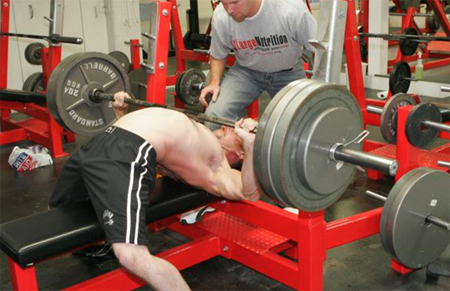Bench press - arching the back
Replies
-
PocketPoodle wrote: »PocketPoodle wrote: »jonthemusse wrote: »For somebody not competing, or training to compete, what is the advantage in using a technique not aiming to maximize recruitment or range? Genuine question.
Shoulder safety, greater stability.
Number of back injuries I've personally had or even heard about on bench: 0
Number of shoulder injuries or pec tears I've heard about on bench: tons
^ Yes that's anecdote of course.
Actually, I did feel more wobbly when trying to arch less. A shoulder injury is one of my biggest fears, I'm a pianist
People often tell me I have a really huge pianist.
But more to the main point in case this helps:
For powerlifting clients I will have them arch as much as possible such that they are still competing within the rules of the competition AND assuming this results in more weight moved.
For clients who are interested in maximum bench press strength I will do the same.
For clients who do not have the goal of building the biggest bench they can, I will STILL have them meet the following criteria:
1) SOME arch, the degree of which determined by their mobility and comfort levels, but generally I don't want them completely flat backed.
2) Scapula retracted and shoulders packed firmly into the bench
3) Feet firmly planted into the floor and remaining there throughout the press
4) Chest elevated (pushed UP towards the barbell)
5) Butt planted on the bench
This will look different from person to person. For some that's going to be a very small lumbar arch, for others it might be "moderate" but it's not going to be a large arch where I'm trying to stuff them under the bench.
Hah!

And thank you so much! I might try to make a video and post it in the form critique thread.
Feel free to do so. Sometimes I miss new posts in that thread so feel free to PM me when you post and I'll take a look.
Thank you, and will do!
0 -
PocketPoodle wrote: »I did have some SI joint issues (still an issue sometimes), and back then, my physical therapist told me to bench press with my feet on the bench. But he also had me bench press in the smith machine...
If a medical professional tells you to bench with feet on the bench, i would listen to them over us.
If you choose to arch, make damn sure your abs (which counteract the arch) keep a consistent level of contraction, especially on the last rep. It's natural to try to increase the arch suddenly when struggling, and that sudden movement could cause one to "throw out" their back, if they are prone to those things, as you may, since you have SI joint issues.
By the way, arching essentially turns the movement into a decline bench press, which activates more of the chest because the fibers of the muscle mostly point downward, as you can see here. If you want to be safe about it, just do a decline bench press and it will accomplish similar results as arching.
0 -
jonthemusse wrote: »Yeah, she did mention in the end to keep the rear on the bench. I had something like this in mind when I was whining

I don't think I reach quite that level of arching
0 -
Cherimoose wrote: »PocketPoodle wrote: »I did have some SI joint issues (still an issue sometimes), and back then, my physical therapist told me to bench press with my feet on the bench. But he also had me bench press in the smith machine...
If a medical professional tells you to bench with feet on the bench, i would listen to them over us.
If you choose to arch, make damn sure your abs (which counteract the arch) keep a consistent level of contraction, especially on the last rep. It's natural to try to increase the arch suddenly when struggling, and that sudden movement could cause one to "throw out" their back, if they are prone to those things, as you may, since you have SI joint issues.
By the way, arching essentially turns the movement into a decline bench press, which activates more of the chest because the fibers of the muscle mostly point downward, as you can see here. If you want to be safe about it, just do a decline bench press and it will accomplish similar results as arching.
I get what you're saying, and I will ask him next time I see him. He told me that I would work my core more with the feet on the bench, and I did follow his advice for some time, but then the SI joint got more stable and I guess I wanted to see how it was with my feet on the floor. I strengthen my core in other ways.
I'm not so afraid of hurting my back anymore, though I am of course careful. When the pain starts creeping back - usually if I've been sitting for too long - I massage and stretch, and it's good again.0 -
jonthemusse wrote: »Feet on bench is an aide for people who can't not arch, or lemmings.
Arching is cheating for a given value of cheating.
Solution: don't arch and keep the bench clean. I'm sure some machine manufacturer somewhere has designed a bench with injection molded foot holds complete with oversized straps.
this totally0
This discussion has been closed.
Categories
- All Categories
- 1.4M Health, Wellness and Goals
- 398.2K Introduce Yourself
- 44.7K Getting Started
- 261K Health and Weight Loss
- 176.4K Food and Nutrition
- 47.7K Recipes
- 233K Fitness and Exercise
- 462 Sleep, Mindfulness and Overall Wellness
- 6.5K Goal: Maintaining Weight
- 8.7K Goal: Gaining Weight and Body Building
- 153.5K Motivation and Support
- 8.4K Challenges
- 1.4K Debate Club
- 96.5K Chit-Chat
- 2.6K Fun and Games
- 4.7K MyFitnessPal Information
- 17 News and Announcements
- 21 MyFitnessPal Academy
- 1.5K Feature Suggestions and Ideas
- 3.2K MyFitnessPal Tech Support Questions


